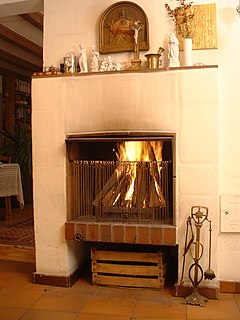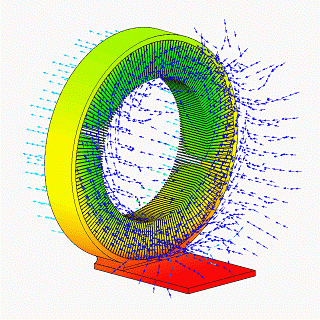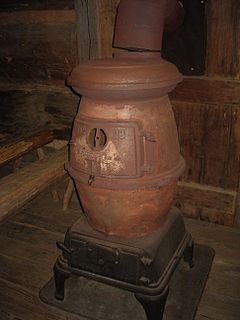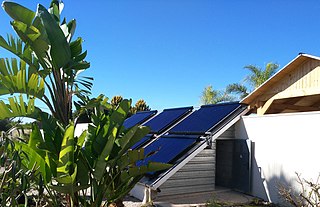 W
WA combined storage tank combines hot water storage both for heating support and drinking water heating in a larger tank. As a result, warm water, typically from solar thermal energy, is stored temporarily for both purposes for later consumption. Breaks in sunshine can thus be bridged without any additional heating, depending on the heating requirement and storage size. This generally takes up less space than two individual buffer tanks and thermal losses are thereby reduced. These storage tanks are mostly insulated on the outside and designed for the lowest possible heat losses. Usually, it is a tank-in-tank system, that is, a two-compartment system arranged one inside the other. It is thus a combined buffer storage tank with a heat exchange plate in between. Above is a smaller interior tank for drinking water, i.e. water for showers, washing etc. and around it on the outside is a much larger storage volume for heating water for room heating.
 W
WAn electric fireplace is an electric heater that mimics a fireplace burning coal, wood, or natural gas. Electric fireplaces are often placed in conventional fireplaces, which can then no longer be used for conventional fires. They plug into the wall, and can run on a "flame only" setting, or can be used as a heater, typically consuming 1.4-1.6 kW, that can heat a 400 sq ft (37 m2) room.
 W
WESSE is a United Kingdom brand of heating appliances, notable for having been, in the early 19th century, the first to bring the North American type of enclosed heating stoves to Europe.
 W
WA fan heater, also called a blow heater, is a heater that works by using a fan to pass air over a heat source. This heats up the air, which then leaves the heater, warming up the surrounding room. They can heat an enclosed space such as a room faster than a heater without fan, but, like any fan, create audible noise.
 W
WA fireplace or hearth is a structure made of brick, stone or metal designed to contain a fire. Fireplaces are used for the relaxing ambiance they create and for heating a room. Modern fireplaces vary in heat efficiency, depending on the design.
 W
WForced-air gas heating systems are used in central air heating/cooling systems for houses. Sometimes the system is referred to as "Forced hot air".
 W
WA furnace, referred to as a heater or boiler in British English, is a heating unit used to heat up an entire building. Furnaces are mostly used as a major component of a central heating system. The name derives from Latin word fornax, which means oven. Furnaces are permanently installed to provide heat to an interior space through intermediary fluid movement, which may be air, steam, or hot water. Heating appliances that use steam or hot water as the fluid are normally referred to as a residential steam boiler or residential hot water boiler. The most common fuel source for modern furnaces in North America and much of Europe is natural gas; other common fuel sources include LPG, fuel oil and in rare cases coal or wood. In some areas electrical resistance heating is used, especially where the cost of electricity is low or the primary purpose is for air conditioning. Modern high-efficiency furnaces can be up to 98% efficient and operate without a chimney, with a typical gas furnace being about 80% efficient. Waste gas and heat are mechanically ventilated through PVC pipes that can be vented through the side or roof of the house. Fuel efficiency in a gas furnace is measured in AFUE. Furnaces primarily run on natural gas or electricity. Furnaces that are used to boil water are called boilers.
 W
WA tubular grate heater is any grate or heat exchanger for a fireplace designed from metal tubing. Through the tubing is circulated home air that becomes heated by the fire. The air is then vented back into the room and home. It is a heat recovery device that improves the efficiency and ability of a fireplace to get the heat from the fire out and into the home. From simple to ornate, they can contribute significantly to the overall comfort of a room and potentially to a whole house. This in turn will reduce the amount of firewood needed to achieve the same comfort level, potentially reducing heating costs and expenses. Heaters increase the efficiency of a fireplace and hence the amount of heat that makes it from the fireplace out into the home. They work by having naturally convected and forced air funneled into the metal heat exchanger tubing that is then heated by the coals and/or fire. They draw in cold air from the floor and blow heated air back out into your home. This adds an element of conductive and convective heating to the radiant heat typical of a basic fireplace. Grate heaters have been called many things: heatilator, hearth heater, fireplace blower, fireplace grate heater, Fireplace Furnace, tubular grate heater, etc.
 W
WA heat spreader transfers energy as heat from a hotter source to a colder heat sink or heat exchanger. There are two thermodynamic types, passive and active. The commonest sort of passive heat spreader is a plate or block of material having high thermal conductivity, such as copper, aluminum, or diamond. An active heat spreader speeds up heat transfer with expenditure of energy as work supplied by an external source.
 W
WA high efficiency glandless circulating pump is a component of a heating and air conditioning system that allows the system to perform with increased efficiency while significantly reducing the system's electrical usage.
 W
WA hot water storage tank is a water tank used for storing hot water for space heating or domestic use.
 W
WA kerosene heater, also known as a paraffin heater, is typically a portable, unvented, kerosene-fueled, space heating device. In Japan and other countries, they are a primary source of home heat. In the United States and Australia, they are a supplemental heat or a source of emergency heat during a power outage. Most kerosene heaters produce between 3.3 and 6.8 kilowatts.
 W
WA masonry heater is a device for warming an interior space through radiant heating, by capturing the heat from periodic burning of fuel, and then radiating the heat at a fairly constant temperature for a long period. Masonry heaters covered in tile are called cocklestoves. The technology has existed in different forms, from back into the Neoglacial and Neolithic periods. Archaeological digs have revealed excavations of ancient inhabitants utilizing hot smoke from fires in their subterranean dwellings, to radiate into the living spaces. These early forms have evolved into modern systems.
 W
WAn oil burner is a heating device which burns #1, #2 and #6 heating oils, diesel fuel or other similar fuels. In the United States ultra low #2 diesel is the common fuel used. It is dyed red to show that it is road-tax exempt. In most markets of the United States heating oil is the same specification of fuel as on-road un-dyed diesel.
 W
WAn oil heater, also known as an oil-filled heater, oil-filled radiator, or column heater, is a common form of convection heater used in domestic heating. Although filled with oil, it is electrically heated and does not involve burning any oil fuel; the oil is used as a heat reservoir (buffer), not as a fuel.
 W
WOndol or gudeul in Korean traditional architecture, is underfloor heating similar to a Kang bed-stove that uses direct heat transfer from wood smoke to heat the underside of a thick masonry floor. In modern usage it refers to any type of underfloor heating, or to a hotel or a sleeping room in Korean style.
 W
WThe outdoor wood boiler is a variant of the classic wood stove adapted for set-up outdoors while still transferring the heat to interior buildings.
 W
WA patio heater is a radiant heating appliance for generating thermal radiation for outdoor use.
 W
WA potbelly stove is a cast-iron wood-burning stove, round with a bulge in the middle. The name is derived from the resemblance of the stove to a fat man's pot belly. They were used to heat large rooms and were often found in train stations or one-room schoolhouses. The flat top of the fireplace allowed for cooking food or heating water.
 W
WRadiators are heat exchangers used to transfer thermal energy from one medium to another for the purpose of cooling and heating. The majority of radiators are constructed to function in cars, buildings, and electronics.
 W
WRadiators and convectors are heat exchangers designed to transfer thermal energy from one medium to another for the purpose of space heating.
 W
WA radiator reflector is a thin sheet or foil applied to the wall behind, and closely spaced from, a domestic heating radiator. The intention is to reduce heat losses into the wall by reflecting radiant heat away from the wall. It is a form of radiant barrier and is intended to reduce energy losses and hence decrease fuel expenditure.
 W
WThe Red Cross stove is a kitchen or parlor stove used for cooking and heating mainly North American homes of the late 19th and early 20th century. The reason for the name "Red Cross" was because of the advertising logo, which featured a red Gothic cross.
 W
WA rocket mass heater (RMH), also known as rocket stove mass heater, is a form of slow-release radiant heating system, designed to primarily heat people and secondary to warm areas in line of sight around it. Variations of RMH can also be extended for the functions of cooking, heating water, and producing warm air for distribution.
 W
WA Russian stove is a unique type of masonry stove that first appeared in the 15th century. It is used both for cooking and domestic heating in traditional Russian, Ukrainian and Belarusian households. The Russian stove burns firewood or wood manufacturing waste.
 W
WA smoke canopy is a device hung over a fire to gather the smoke and vent it through a wall or roof.
 W
WThe Sofono Spacemaster, and Spacemaster range of domestic electric convector or convector/reflector heaters was produced by the Sofono Electrical Division of Federated Foundries Ltd, Falkirk, Scotland, UK in the mid-20th century. Their distinctive appearance, often referred to as “atomic”, “flying-saucer” or “sputnik”, has ensured their popularity amongst retro style enthusiasts from the late 1990s onwards.
 W
WSolar water heating (SWH) is heating water by sunlight, using a solar thermal collector. A variety of configurations is available at varying cost to provide solutions in different climates and latitudes. SWHs are widely used for residential and some industrial applications.
 W
WA space heater is a device used to heat a single, small area; central heating is used to heat many connected areas, such as the rooms of a house. Space heaters are powered by electricity or a burnable fuel, such as natural gas, propane, fuel oil, or wood pellets. Portable space heaters are usually electric, because a permanent exhaust is needed for heaters which burn fuel.
 W
WA storage heater or heat bank (Australia) is an electrical heater which stores thermal energy during the evening, or at night when electricity is available at lower cost, and releases the heat during the day as required.
 W
WA storage water heater, or a hot water system (HWS), is a domestic water heating appliance that uses a hot water storage tank to maximize heating capacity and provide instantaneous delivery of hot water. Conventional storage water heaters use a variety of fuels, including natural gas, propane, fuel oil, and electricity. Less conventional water heating technologies, such as heat pump water heaters and solar water heaters, can also be categorized as storage water heaters.
 W
WA towel rails radiator or a heated towel rail is a feature designed to heat towels before using them. For many years, European hotels have used them as combined towel- dryers/racks. The towel warmer is a bathroom heater suitable for both drying and heating towels and the environment. There are two versions: traditional ones that are plumbed like a radiator with water heated from a central boiler, and electric ones where an electrical resistance heats water or oil contained in the unit
 W
WA wood-burning stove is a heating appliance capable of burning wood fuel and wood-derived biomass fuel, such as sawdust bricks. Generally the appliance consists of a solid metal closed firebox, often lined by fire brick, and one or more air controls. The first wood-burning stove was patented in Strasbourg in 1557, two centuries before the Industrial Revolution, which would make iron an inexpensive and common material, so such stoves were high end consumer items and only gradually spread in use.